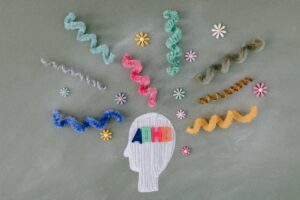
Despite the fact that ADHD is one of the most common childhood disorders, a growing number of adults are getting diagnosed. You may be asking, “Why the sudden uptick?”
Well, oftentimes signs of attention-deficit/hyperactivity disorder (ADHD) in children can go unnoticed by teachers and parents—especially when we factor in how ADHD can present itself differently in girls vs. boys.
As knowledge about ADHD expands, so does our understanding of this disorder and its signs. So what does ADHD look like later in life? Keep reading to find out.
What is ADHD?
Also known as attention-deficit/hyperactivity disorder, ADHD is a neurodevelopmental disorder, which is a category of disorders marked by conditions that affect growth and development of the brain and how it functions.
ADHD can cause certain brain regions to become hyperactive (highly active beyond standard levels) and others to become hypoactive (less active than standard levels).
As Medical News Today puts it: “A person with ADHD may be unable to suppress brain activity in the default attention network, especially as a task becomes more difficult. This may link to more distractibility.”

Signs of ADHD in Adults
ADHD doesn’t just affect children and teens. It’s estimated that close to 10 million adults have ADHD, according to recent numbers from Children and Adults with Attention-Deficit/Hyperactivity Disorder (CHADD).
For those whose ADHD went undiagnosed during childhood, the following reasons may have been at play:
- Parents or teachers may not have noticed signs of ADHD, or may not have known the signs of ADHD to look out for in the first place
- The severity of their ADHD could have been mild
- Despite having ADHD, they performed well academically
- Masked signs of ADHD
- Signs of ADHD can differ by genders
Another possible reason for delayed ADHD diagnosis is that the stresses of adulthood—such as work, higher education, and increased responsibilities (finances, family, less support, etc.)—can exacerbate ADHD symptoms and make them harder to manage.
Signs of ADHD in Adults Include:
- Regular hyperactivity, which can look like:
- Restlessness or an inability to sit still
- Stimming or fidgeting, as in repeating certain sounds or body movements unconsciously (for example, rocking back and forth, pacing around, grinding teeth, doodling, nail biting, etc.)
- Zoning out or daydreaming
- Trouble paying attention for long periods of time or becoming easily distracted
- Disorganization, such as constantly having a cluttered home, car or desk
- Having trouble finishing tasks
- Becoming easily overwhelmed
- Making careless mistakes on tasks, such as work projects
- Losing interest in tasks easily, especially with things you find to be boring or repetitive
- Hyperfocusing or fixating on interesting tasks or subjects
- Struggling with motivation
- Forgetfulness
- Procrastination
- Poor time management
- Reacting strongly to relatively small stressors or inconveniences
- Impatience
- Sudden shifts in moods
- Angry outbursts
- Indecisiveness or feelings overwhelmed when faced with choices
- Overstimulation
- Excessive talking, blurting things out, and unintentionally interrupting others

ADHD Signs in Women vs. Men
During both childhood and adulthood, ADHD can look different according to gender.
The CDC reports that 13% of boys (ages 3-17) in the U.S. are diagnosed with ADHD, compared to 6% of girls (ages 3-17). However, due to underrecognized and underreported signs of ADHD in females, the prevalence of ADHD among girls is likely higher than reported.
Signs of ADHD in Females*:
- Maladaptive daydreaming
- Anxiety
- Depression
- Spacing out during conversations
- Easily losing focus
- Auditory processing disorder
- Forgetfulness
- Eating disorders
- Hypersexuality
- Impatience
- Body-focused repetitive behaviors (e.g. skin picking, hair pulling, leg bouncing)
- Fatigue
- Insomnia
- Crying with deep emotion, anger, and feelings of guilt and shame
- Shyness due to social anxiety and sensory sensitivities
- Rejection sensitivity dysphoria (RSD) symptoms
- Perfectionism
- People-pleasing
- Codependency
- Body dysphoria
- Low self-esteem
- Overachieving
- Underachieving
- Overwhelm
- Intense emotional reactions
Hormone levels*—in particular estrogen levels—can also impact the severity and intensity of ADHD symptoms at different stages of life, including: puberty, monthly menstrual cycles, perimenopause and menopause.
Signs of ADHD in Males*:
- Hyperactivity (e.g. fidgeting)
- Disruptive behavior
- Frequently losing items
- Interrupting others during conversations
- Aggressive behaviors
- High risk behaviors (e.g., substance misuse, speeding, unhealthy sexual behaviors, excessive financial spending)
- Insecurity—more often presented externally as the following:
- Anger
- Apathy
- Self-centeredness
- Seeming insensitive to other people’s emotions
- Teasing others or being sarcastic
- Needing to be right or proving others wrong
- Defensiveness
Due to the way ADHD presents itself in females and how they cope with symptoms, signs of this disorder may be brushed off as “perfectionism” or being “emotional.” Women and girls are also less likely to express hyperactivity and impulsivity externally.
The signs of ADHD in males have historically been used as a standard for ADHD diagnosis—in part because males typically show symptoms in a more external manner, and in part due to gender bias.
*Source: https://psychcentral.com/adhd/adhd-and-gender

How is ADHD Diagnosed?
There are multiple tests used to diagnose ADHD in both children and adults. If you Google “ADHD testing,” you’ll find plenty of online self-diagnosis tests—however, licensed medical professionals like psychiatrists and primary care physicians (PCPs) are the only people who can provide an accurate ADHD diagnosis.
After speaking with your doctor, they may decide that it makes sense for you to do a psychological assessment, which will help determine if an ADHD diagnosis is fitting.
Popular ADHD Assessments Include:
- The Test of Variables of Attention (TOVA)
- Behavior Rating Inventory of Executive Functioning-Adult Version (BRIEF-A)
- Barkley Adult ADHD Rating Scale-IV (BAARS)
- Conners’ Adult ADHD Rating Scales (CAARS)
Treating ADHD
Therapy, medication and social support are three of the best ways to treat ADHD. At Valera Health, we happen to offer all three. Our virtual services include both individual and group therapy, psychiatry and medication management. Currently, we offer multiple ADHD support groups in New York, and other therapy groups in additional states (more to come soon!). Our Health Connectors are here to help you begin your treatment journey. Visit https://www.valerahealth.com/consult-today/ or click here to get started with a free consultation. For additional ADHD support resources, click here.
Thanks to the expansion of research on ADHD in adults, signs and symptoms of ADHD are becoming more widely understood. While we still have a ways to go, the future of ADHD treatment and diagnosis looks bright.